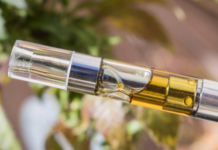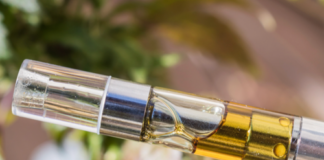
Chronic pain is an epidemic in the United States with more than 50 million people living with mild to intense discomfort every day, according to the Centers for Disease Control and Prevention (CDC). Some of this pain may be attributed to a sedentary lifestyle and 40 hours or seated behind a desk, while other types of pain may follow a serious accident or diagnosis of disease.
Whether chronic pain originates from modern life, an injury, or a disorder such as fibromyalgia, it can be debilitating to those who cope with it daily. Prescription pain pills and over-the-counter medications often come with a slew of side effects, as well as the risk for addiction. Consequently, many pain sufferers are on a quest for a treatment that doesn’t leave them groggy or in desperate need of the next fix.
Responding to the call for better pain treatment options, the New York State Department of Health announced in 2018 that opioid replacement will be considered a qualifying condition for obtaining a medical marijuana card.
Chronic pain affects more than 50 million people in the United States. (Weedmaps file photo)
Could cannabis be the safe, natural remedy to fight back against persistent pain and addictive opioids?
Research Overview
Reuters reported on Feb. 6, 2019, that pain is by far the No. 1 reason why patients request medical marijuana. Word of mouth is a primary factor in people seeking cannabis medicine to soothe their pain, and there are studies to support the anecdotal evidence.
The Studies
Smoked or vaporized cannabis was found to be consistently effective in treating non-cancer pain, according to a 2017 study published in Current Rheumatology Reports. Researchers in this study also reported that oral cannabinoids showed better results in treating certain kinds of pain than others. Sleep and general quality of life were enhanced through oral cannabinoid usage and a reduction in cancer pain was noted as well. On the other hand, oral cannabinoids appeared to have little effect on acute postoperative pain, abdominal pain, or rheumatoid pain.
A clinical trial completed in 2018 at the University of California, Davis, analyzed the effects of vaporized marijuana on neuropathic pain. Results revealed that medium doses of cannabis were slightly more effective than low doses in relieving this type of prickling and tingling pain. Further, both level doses were significantly more effective than placebos for patients in this study.
When it comes to research on cannabis and pain, findings are mixed, but results indicate certain types of pain respond well to cannabinoid therapy. (Weedmaps File Photo)
Other studies, such as a 2018 report published in The Lancet, have found no correlation between cannabis use and pain relief. Despite conflicting findings, researchers are still working to establish a clear link between medical marijuana use and pain reduction.
For example, a clinical trial launched in 2018 at the University of Colorado, Boulder, is examining the effects of edibles on pain, inflammation, and cognition. Enrolling 283 participants, the observational study aims to differentiate between how cannabidiol (CBD) and THC function in this trio of areas.
More clinical trials and studies are likely to emerge in the near future, but for now, some pain sufferers are shaping their own health destinies.
Patient Perspectives
Massachusetts resident Laura Kiesel suffers from a rare connective tissue disorder, Ehlers-Danlos syndrome, which causes severe pain and limits her mobility. She documented her journey to healing for Healthline, detailing how she chews medical marijuana gummies before bed on most evenings. Refreshing sleep, increased mobility, and decreased pain are among the benefits Kiesel has experienced. She elaborated, “I stopped researching wheelchairs online and devoted more of my time to doing all the things I wasn’t able to do before — such as writing and enjoying the outdoors.”
While Kiesel is not entirely pain-free, she has been able to drastically reduce her pain pill usage from several times a week to just a few times a month since starting her cannabis regimen.
Kiesel is not alone in her experiences. Diana Whitney, a mother of two from Vermont, began using medical marijuana to combat chronic pain and now also uses it for anxiety and depression. In her 2018 article published in The Washington Post, Whitney shared: “Applying the butter topically soothed my chronic pelvic pain and relieved symptoms of the debilitating bladder syndrome that had plagued me for a decade … .”
Patients who use cannabis to ease pain report enjoying the opportunity to spend quality time with children and pets. (Shutterstock photo)
Whitney did not, however, enjoy the intoxicating effects of medical marijuana, so now she microdoses in small amounts, which help her ailments without the high that she dislikes. She explained, “When I microdose, I experience a heightened sense of gratitude and patience, as well as lighthearted humor. Joining the kids on the couch for a lovefest with the dog or playing a family game of cards, I feel more present, more grounded in my body, free from mental agitation.”
Yoga teacher Jane Lanza shared her own similar experiences with microdosing in Whitney’s article: “The spirit of healing I receive from medical cannabis is nurturing and supportive. It amplifies positive feelings for me, so I experience greater love, patience, and compassion when it comes to my kids.”
What the Experts Say
Many medical experts are on board with cannabis as a potent treatment option for chronic pain. “Medical marijuana, in my opinion, is an excellent choice for patients with chronic disease, including chronic pain,” said Dr. Laszlo Mechtler, medical director of the Dent Neurologic Institute in Amherst, New York, in a March 2019 interview for the Chicago Tribune.
Mechtler served as senior researcher for a study of 204 adults ages 75 and older who took cannabis to ease various aches and pains. Seventy percent of the patients experienced pain relief, while one-third of the patients also reported reduced dependency on opioid painkillers.
“In the midst of an opioid epidemic in this country, with 115 people dying every day, anything that can decrease the potential for opiate use is a win/win situation. Nobody overdoses on medical marijuana,” Mechtler added.
The primary issue Mechtler foresees is unrelated to side effects — and directly related to politics and economics. Prescriptions for Mechtler’s medical marijuana patients cost as much as $500 a month out-of-pocket, a figure that is simply unaffordable for many Americans. “Thirty-five percent of my patients can’t afford it at all, period, and 70 percent complain of the significant cost and how it affects their quality of life financially,” Mechtler said.
Dr. Diana Martins-Welch, an attending physician in palliative medicine at Northwell Health in Long Island, New York, perceives another pertinent issue regarding cannabis: “Honestly, it’s going to have to be federally legal before we can do the robust studies that are required of medicine in general.”
The Bottom Line
Countless individuals have experienced considerable pain relief from cannabis medicine, but until medical marijuana is legalized at the federal level, many will have difficulty obtaining and affording this potential remedy.











